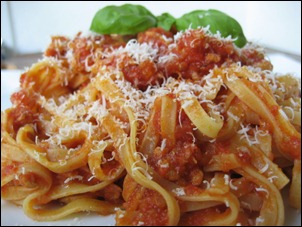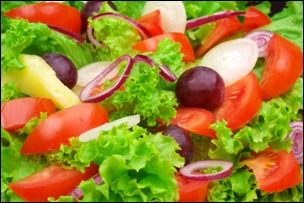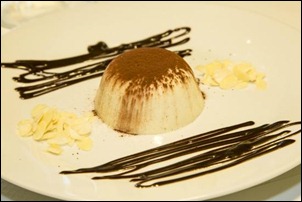Eating Out In Italy – With Special Dietary Requirements Posted by Serena on May 27, 2014 in Italian Language
A few days ago it was my father’s birthday, and we decided to celebrate by taking him out for a meal. Now, out of the six of us who went to the restaurant, only one didn’t have any specific dietary requirement: mia madre! Here’s a brief account in Italian of the rather complicated process of ordering our meals. But first, let’s meet the main ‘protagonists’, and find out what their dietary requirements are:
Mio padre: non può mangiare le uova = my father can’t eat eggs
Geoff ed io: siamo vegetariani = Geoff and I are vegetarians
Zio Luciano: è diabetico = Uncle Luciano is diabetic
Fiorino, un amico di famiglia: è celiaco, il che vuol dire che è allergico al glutine = Fiorino, a family friend, is celiac, meaning that he’s allergic to gluten
Primo Piatto = First Course
Cameriere: “Come primi cosa volete ordinare?”
Waiter: “What would you like to order for the first course?”
Io: “Mio marito ed io siamo vegetariani. I tortelli ai funghi hanno carne?”
Me: “My husband and I are vegetarian. Do the tortelli with mushroom have meat?”
Cameriere: “No, li facciamo noi, e hanno un ripieno di spinaci, ricotta ed erbette. Sono molto buoni, ve li consiglio”
Waieter: “No, we make them ourselves, and they are filled with spinach, ricotta cheese and wild herbs. They are very nice, I recommend them”
Io: “Va bene, due tortelli ai funghi per favore”
Me: “OK, two tortelli with mushrooms please”
Mio padre: “Io vorrei la pasta al ragù, ma non posso mangiare uova. Avete della pasta senza uovo?”
My father: “I’d like pasta with ragout, but I can’t eat eggs. Do you have pasta without eggs?”
Cameriere: “Certamente. Invece delle tagliatelle possiamo farle degli spaghetti o delle penne al ragù, cosa preferisce?”
Waiter: “Certainly. Instead of tagliatelle we could cook you some spaghetti or penne with ragout, what would you prefer?”
Mio Padre: “Penne al ragù per favore”
My father: “Penne with ragout please”
Fiorino: “Io sono celiaco, potrei avere il ragù con il riso o la polenta?”
Fiorino: “I’m celiac, can I have ragout with rice or polenta?”
Cameriere: “Se preferisce abbiamo anche la pasta per celiaci. Mi dica lei”
Waiter: “If you prefer we also have pasta for celiacs. You tell me (take your pick)”
Fiorino: “Allora prendo la pasta al ragù”
Fiorino: “In that case I’ll have pasta with ragout”
Zio Luciano: “Io e la signora prendiamo risotto ai funghi”
Uncle Luciano: “Me and this lady will have risotto with mushrooms”
Cameriere: “Allora, ricapitoliamo: due tortelli ai funghi, una penna al ragù, una pasta senza glutine al ragù, due risotti ai funghi. Va bene?”
Waiter: “OK, let’s recap: two tortelli with mushrooms, one penne with ragout, one pasta without gluten with ragout, two risotto with mushrooms. Is that correct?”
Noi: “Perfetto”
Us: “Perfect”
Secondo Piatto = Second Course
Cameriere: “Per secondo?”
Waiter: “For the second course?”
Io: “Essendo vegetariani prendiamo un’insalatona San Giorgio da condividere”
Me: “As we’re vegetarians we’ll have one insalatona San Giorgio (a big plate of mixed salad made by the restaurant San Giorgio) to share”
Fiorino: “Carne alla griglia per noi tre” (indicando i miei genitori)
Fiorino: “Grilled meat for us three” (indicating my parents)
Zio Luciano: “Per me costolette di agnello con patate fritte”
Uncle Luciano: “For me lamb chops with fried potatoes”
Dopo … il dolce (Later … the dessert)
Cameriere: “Tutto bene? Desiderate ordinare il dolce?”
Waiter: “Is everything all right? Would you like to order dessert?”
Mio padre: “Cosa avete senza uova?”
My father: “What do you have without eggs?”
Cameriere: “Un momento che vado a chiedere in cucina” … “Allora, l’unico dolce senza uova è la panna cotta, che facciamo noi”
Waiter: “Just a moment whilst I’ll go and ask in the kitchen” … “Well, the only dessert without eggs is panna cotta (lit. cooked cream), which we make ourselves”
Mio padre: “Va bene la panna cotta”
My father: “Panna cotta is fine”
Io: “La panna cotta è fatta con gelatina animale, vero?”
Me: “Panna cotta is made with animal gelatine, isn’t it?”
Cameriere: “Sì, non è vegetariana”
Waiter: “Yes, it’s not vegetarian”
Io: “In questo caso prendo un sorbetto al limone, e uno anche per mia madre”
Me: “In that case I’ll have a lemon sorbet, and one for my mother as well”
Geoff: “Io prendo il mio dolce preferito, la torta di pere e cioccolato”
Geoff: “I’ll have my favourite dessert, pear and chocolate cake”
Zio Luciano: “Essendo diabetico, purtroppo non posso mangiare i dolci … avete della frutta fresca?”
Uncle Luciano: “As I’m diabetic, unfortunately I can’t eat sweets … do you have fresh fruit?”
Cameriere: “Abbiamo dell’ottimo ananas fresco”
Waiter: “We have some excellent fresh pineapple”
Zio Luciano: “D’accordo”
Uncle Luciano: “That’s fine”
Fiorino: “Anch’io prendo l’ananas”
Fiorino: “I’ll have pineapple as well”
If you have special dietary requirements, eating out in Italy isn’t usually too difficult, especially as meals are served as a series of piatti, rather than one dish with everything on it (as in traditional English cooking for example), so it’s usually quiet easy to pick and choose. The important thing is to be able to communicate your specific needs:
sono vegetariano – siamo vegetariani (I’m vegetarian – we are vegetarian) Link: http://www.ristorantevegetariano.it/
sono diabetico – siamo diabetici (I’m diabetic – we are diabetic)
sono celiaco – siamo celiaci (I’m celiac/allergic to gluten – we are celiac/allergic to gluten)
sono allergico a …. (I’m allergic to ….)
You’ll usually be asked if you’d like coffee at the end of your meal. If you don’t drink caffeine you could always ask for un caffè decaffeinato, or simply un caffè deca. Otherwise you could have un caffè d’orzo, which is a coffee alternative made with roasted barley.
If you need help with any aspect of dealing with special dietary requirements in Italy please leave a comment.

Build vocabulary, practice pronunciation, and more with Transparent Language Online. Available anytime, anywhere, on any device.








Comments:
Jeary:
Thank you for this post — it gave me a big smile. Being vegan, I am usually the one person at the table that causes a lot of trouble! But reading your account, I guess, I am not the only one to whom that happens. 🙂 (And so far, Italian restaurants were by far the best to adapt!)
Linda:
I will be traveling in Italy this month, and I am lactose intolerant so I need to avoid cream, cow cheeses, etc. I would appreciate yur help with the correct way to communicate this in a restaurant.
Serena:
@Linda Salve Linda!
Ecco un po’ di vocabolario:
soffro di intolleraza al lattosio
non posso mangiare latte, panna, formaggio di mucca, latticini (dairy products)
Al supermercato si può comprare latte e yogurt di soia ed altri sostituti del latte, ma anche latte senza lattosio “alta digeribilità”.
Let me know if you need more vocabulary
Auguri da Serena